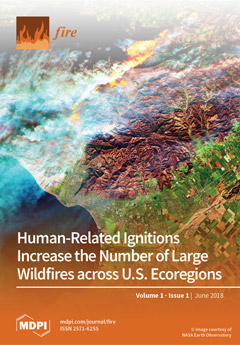Open AccessCase Report
The Cooney Ridge Fire Experiment: An Early Operation to Relate Pre-, Active, and Post-Fire Field and Remotely Sensed Measurements
by
Andrew T. Hudak, Patrick H. Freeborn, Sarah A. Lewis, Sharon M. Hood, Helen Y. Smith, Colin C. Hardy, Robert J. Kremens, Bret W. Butler, Casey Teske, Robert G. Tissell, Lloyd P. Queen, Bryce L. Nordgren, Benjamin C. Bright, Penelope Morgan, Philip J. Riggan, Lee Macholz, Leigh B. Lentile, James P. Riddering and Edward E. Mathews
Cited by 9 | Viewed by 7016
Abstract
The Cooney Ridge Fire Experiment conducted by fire scientists in 2003 was a burnout operation supported by a fire suppression crew on the active Cooney Ridge wildfire incident. The fire experiment included measurements of pre-fire fuels, active fire behavior, and immediate post-fire effects.
[...] Read more.
The Cooney Ridge Fire Experiment conducted by fire scientists in 2003 was a burnout operation supported by a fire suppression crew on the active Cooney Ridge wildfire incident. The fire experiment included measurements of pre-fire fuels, active fire behavior, and immediate post-fire effects. Heat flux measurements collected at multiple scales with multiple ground and remote sensors illustrate the spatial and temporal complexity of the fire progression in relation to fuels and fire effects. We demonstrate how calculating cumulative heat release can provide a physically based estimate of fuel consumption that is indicative of fire effects. A map of cumulative heat release complements estimates of ground cover constituents derived from post-fire hyperspectral imagery for mapping immediate post-fire ground cover measures of litter and mineral soil. We also present one-year and 10-year post-fire measurements of overstory, understory, and surface conditions in a longer-term assessment of site recovery. At the time, the Cooney Ridge Fire Experiment exposed several limitations of current state-of-science fire measurement methods, many of which persist in wildfire and prescribed fire studies to this day. This Case Report documents an important milestone in relating multiple spatiotemporal measurements of pre-fire, active fire, and post-fire phenomena both on the ground and remotely.
Full article
►▼
Show Figures





